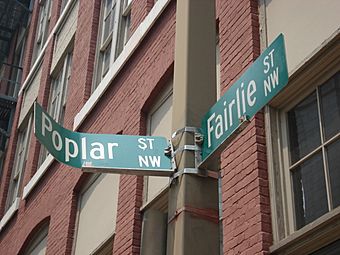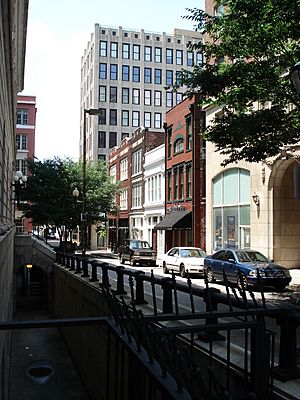Fairlie–Poplar, Atlanta facts for kids
Quick facts for kids |
|
|
Fairlie–Poplar Historic District
|
|
 |
|
| Lua error in Module:Location_map at line 420: attempt to index field 'wikibase' (a nil value). | |
| Location | Atlanta, GA |
|---|---|
| Architectural style | Chicago, art deco |
| NRHP reference No. | 82002416 |
| Added to NRHP | September 9, 1982 |
The Fairlie–Poplar Historic District is a special area in downtown Atlanta, Georgia. It's like a time capsule showing how the city looked in the late 1800s and early 1900s. This district gets its name from two streets, Fairlie and Poplar, which cross in the middle of the area.
Fairlie–Poplar is just north of Five Points, which is a very important spot and has been Atlanta's main business center for a long time. The district has smaller city blocks than other parts of Atlanta, and its streets run at a unique 40-degree angle.
You'll find many old office and business buildings here. They show off different building styles popular back then, like Chicago style, Art Deco, and Victorian. These buildings also show how construction changed from using heavy masonry (like brick and stone) to lighter steel frames and concrete. Some famous buildings in this district include the Flatiron Building and the Healey Building.
Exploring the History of Fairlie–Poplar
This historic district grew a lot in the late 1800s. Back then, Atlanta was becoming a major business hub for the whole Southeast. The area was even called "Atlanta's new modern fireproof business district."
After the Civil War, Atlanta's main business area was mostly along Peachtree and Alabama Street. The Fairlie–Poplar district marked a big expansion northwards. It became home to many different kinds of businesses. You could find places selling things in bulk (wholesale) and stores selling directly to customers (retail). Many of Atlanta's main offices and government agencies were also located here.
The buildings were made from materials like brick, stone, and even fancy glazed terra-cotta. They range in height from just two stories to as tall as 16 stories! The taller buildings were built with strong concrete or steel frames. Smaller buildings used older methods with load-bearing walls made of masonry and wood.
Georgia State University's Presence
A few buildings that belong to Georgia State University are actually mixed right into the Fairlie–Poplar district. This helps the university feel like a natural part of the city.
One of the first buildings Georgia State University bought in this area was the former C&S Bank Building in 1993. It's now called the J. Mack Robinson College of Business Administration Building. Later, in 1996, the Rialto Center for the Arts and the Haas-Howell Building also became part of the university.
The Helen M. Aderhold Learning Center is another modern university building on Luckie Street. It's not just for classes; it also has shops and restaurants on the ground floor. This design helps it blend in perfectly with the rest of the district. The Georgia State University School of Music also uses buildings in Fairlie–Poplar, including the Standard Building and parts of the Haas-Howell Building.
![]() This article incorporates public domain material from the National Park Service document "http://www.nps.gov/nr/travel/atlanta/fai.htm".
This article incorporates public domain material from the National Park Service document "http://www.nps.gov/nr/travel/atlanta/fai.htm".



